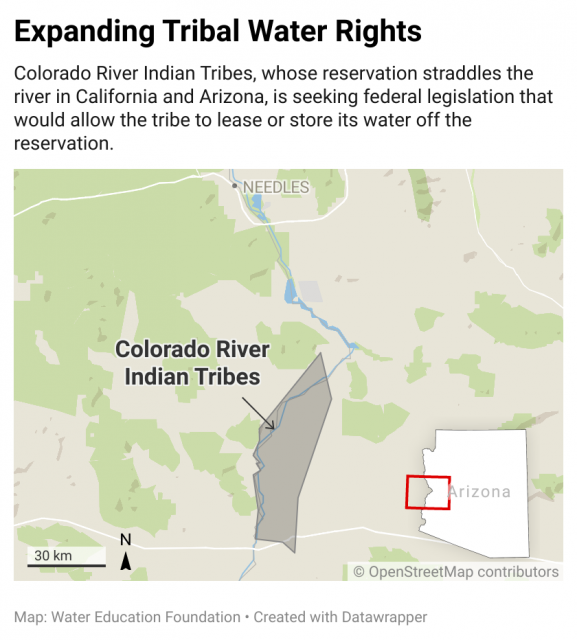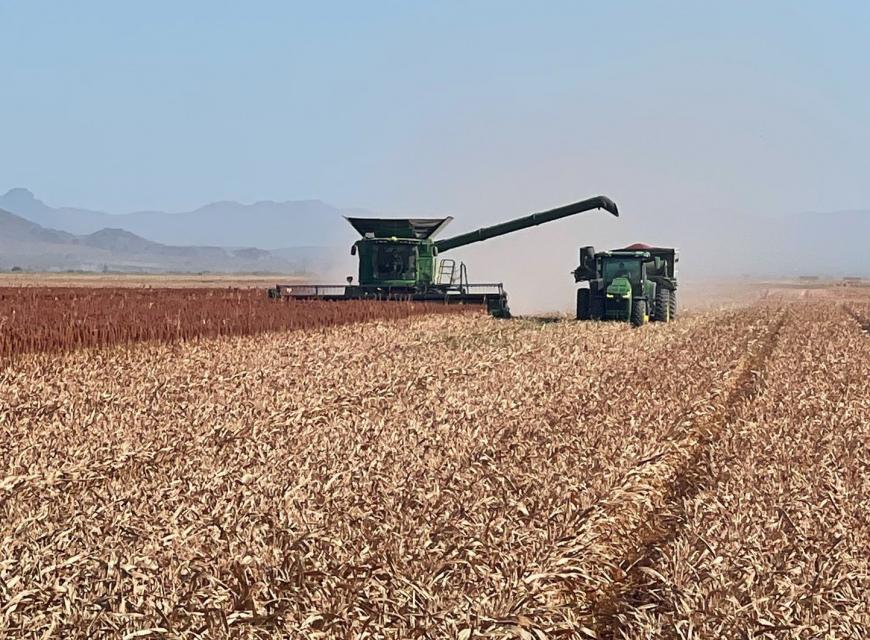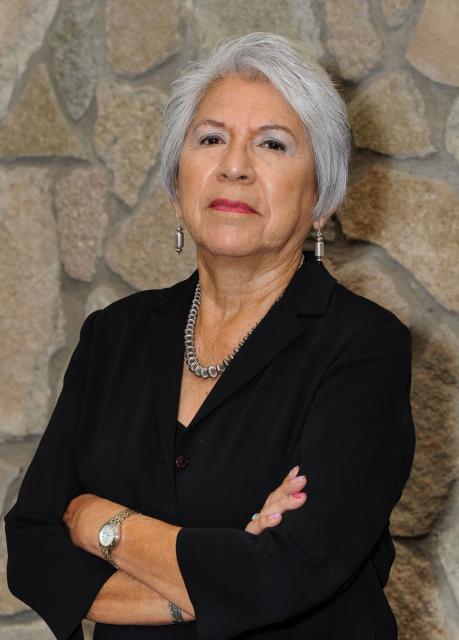A Colorado River Tribal Leader Seeks A Voice In the River’s Future–And Freedom to Profit From Its Water
WESTERN WATER Q&A: CRIT Chair Amelia Flores Says Allowing Tribe to Lease Or Store Water Off Reservation Could Aid Broader Colorado River Drought Response and Fund Irrigation Repairs
 As water interests in the Colorado
River Basin prepare to negotiate a new set of operating
guidelines for the drought-stressed river, Amelia Flores wants
her Colorado River Indian Tribes (CRIT) to be involved in the
discussion. And she wants CRIT seated at the negotiating table
with something invaluable to offer on a river facing steep cuts
in use: its surplus water.
As water interests in the Colorado
River Basin prepare to negotiate a new set of operating
guidelines for the drought-stressed river, Amelia Flores wants
her Colorado River Indian Tribes (CRIT) to be involved in the
discussion. And she wants CRIT seated at the negotiating table
with something invaluable to offer on a river facing steep cuts
in use: its surplus water.
CRIT, whose reservation lands in California and Arizona are bisected by the Colorado River, has some of the most senior water rights on the river. But a federal law enacted in the late 1700s, decades before any southwestern state was established, prevents most tribes from sending any of its water off its reservation. The restrictions mean CRIT, which holds the rights to nearly a quarter of the entire state of Arizona’s yearly allotment of river water, is missing out on financial gain and the chance to help its river partners.
Flores, as CRIT’s tribal chair and the first woman to hold that post, is leading her tribe’s effort to persuade Congress to allow the tribe to lease or store its water off reservation lands like tribes in Arizona and other Colorado River Basin states with congressionally approved deals already can. If Congress grants the request by CRIT, Flores said, the tribe would offer water to aid struggling Arizona farmers and cities as well as wildlife restoration sites throughout the Lower Basin. The bill is pending in a U.S. Senate committee.
 CRIT is comprised of members from
four distinct ethnic groups, the Mohave, Chemehuevi, Hopi and
Navajo tribes, and has set its sights on having a voice in
renegotiation of operating guidelines for the Colorado River,
which must be renewed by 2026. Flores contends the tribe has
proven itself as a valuable partner by recently leaving water in
Lake Mead to alleviate shortages. She hopes CRIT will finally
have a voice in determining the river’s future, unlike previous
negotiations that were crafted without tribal input.
CRIT is comprised of members from
four distinct ethnic groups, the Mohave, Chemehuevi, Hopi and
Navajo tribes, and has set its sights on having a voice in
renegotiation of operating guidelines for the Colorado River,
which must be renewed by 2026. Flores contends the tribe has
proven itself as a valuable partner by recently leaving water in
Lake Mead to alleviate shortages. She hopes CRIT will finally
have a voice in determining the river’s future, unlike previous
negotiations that were crafted without tribal input.
In an interview with Western Water, Flores explains CRIT’s cultural ties to the Colorado River, the proposed legislation and the need for tribes to play larger roles in the upcoming renegotiations.
WESTERN WATER: You refer to the tribes as Aha Makhav, or people of the river. Can you talk briefly about the tribe’s historical relationship with and its cultural ties to the Colorado River?
AMELIA FLORES: Our creator Mataviily created first the stars and the planets and then after he created the animals, he created the people. To go along with that, he created the river and laid aside the lands for us to live off of. This is in our clan songs. The clan songs followed the river from Avii Kwa’ame north of Laughlin, and the Newberry Mountain Range. That is our sacred mountain to the Mohave people. And not only to the Mohave, but to the other tribes along the river. I can’t leave out the mountains. The mountains are very sacred to the Mohave people and they all have names. As stewards of the land and of the river, our identity is in the land and the water. We are the river.
WW: In December of 2020, you were elected by a wide margin to become the first female chair of the Colorado River Indian Tribes. What inspired you to run for the position and, as you said after the election, break the glass ceiling?
FLORES: It goes back to me serving the tribal membership for 29 years as the library archivist. And during that time I was mentored by the Mohave elders, and these were male elders, about the history and the culture of our tribe. The knowledge they passed on was inspiring and I think that is part of me wanting to serve on the tribal council level. And so, it was just moving on to the next level (to become CRIT chair). Also, the passion that I have to serve and help my people is another part that inspired me to continue working for my people.
With the trust and the support of the people, I was elected. It was their support and their vote that broke the glass ceiling, not me. I can provide a woman’s voice to the decisions and to the government.
WW: Under your leadership CRIT is pursuing federal legislation that would allow it to lease or store some of its Colorado River water off the reservation. How would the bill benefit the tribe and how does it fit into broader efforts to share water across the entire Lower Colorado River Basin?
FLORES: The CRIT Resiliency Act didn’t happen overnight. Our past tribal councils had been looking at how we could get more benefit out of, and authority over, our water. Over at least the last 20 years other tribes in Arizona started getting their settlements. With their settlements, they’re able to lease their water that they use from the Colorado River.
 The act will benefit our
sovereignty, the recognition of our sovereignty as the Colorado
River Indian Tribes. Also, from being able to lease – not sell,
but lease – our water, there’s financial benefits that will
provide for our people, provide for the services, provide for our
government, our employees and also it will provide funds to
repair our irrigation system.
The act will benefit our
sovereignty, the recognition of our sovereignty as the Colorado
River Indian Tribes. Also, from being able to lease – not sell,
but lease – our water, there’s financial benefits that will
provide for our people, provide for the services, provide for our
government, our employees and also it will provide funds to
repair our irrigation system.
This bill is just another solution to saving the river and keeping water in Lake Mead, which we have been doing all along. We’ve kept over 200,000 acre-feet of water in Lake Mead through the Colorado River Drought Contingency Plan. We have shown and proven ourselves as CRIT that we do want to be part of the solution. We have first priority and the oldest priority water rights, so when shortages and cuts are being made as the levels go down in Lake Mead, the Central Arizona Project (CAP) will be cut. But with our bill, we can make water available for delivery through the CAP canal and keep that infrastructure going. We can provide a drought supply if the bill is passed.
WW: Looking ahead, what sort of role might CRIT and other tribal groups play in the discussions about the next set of river operating guidelines, which must be finalized by the year 2026? What are some of CRIT’s main priorities heading into these renegotiations?
FLORES: I can only speak for CRIT, not for the other tribes. But we all should play equal roles to the states in these discussions. Each tribe is vital and for so long we’ve been left out of the discussions, we’ve been left out of when plans are developed. With the drought and given the conditions [on the river], we are now being invited to the table, which has been a wake-up call for the Bureau of Reclamation and the United States. We’re all sovereign, we all have our own water rights. But ultimately the United States has its obligations to protect our resources and that’s not only water but other resources, like land for the individual tribes.
“Being able to lease – not sell, but lease – our water, there’s financial benefits that will provide for our people, provide for the services, provide for our government, our employees and also it will provide funds to repair our irrigation system.”
~Amelia Flores, Chairwoman, Colorado River Indian Tribes
I think we need to remain vigilant. We need to hold the Bureau of Indian Affairs and the federal government to their policies. And I believe through negotiation and being at the table, we have a better chance of holding them accountable. We don’t ever want to go back to 10 years, even five years ago when we weren’t consulted.
WW: What is your greatest concern with the Colorado River, especially given the drought?
FLORES: My concern is that there’s a risk the Colorado River could stop flowing if the megadrought continues. Although we would be the last to be cut, it would greatly impact our tribal government and our services to the people. It would impact our environment and the habitat preservation we have going on at the Ahakhav Preserve. I’m hanging on to hope that we have a change in our climate, but there’s a possibility that no water could be flowing along the banks of the river.
WW: CRIT in recent years has participated in the 2019 Drought Contingency Plan and done things like fallow farmland in order to help avoid shortages elsewhere in the Lower Colorado River Basin. Do you think the federal government and the other river users will recognize and credit CRIT’s cooperation and actions during the renegotiation process?
FLORES: Oh yes. With the 200,000 acre-feet of water that we’ve already left in Lake Mead, I don’t think they could overlook us anymore and what we have contributed. And we are now in a relationship with the Arizona Department of Water Resources and also CAP. So in developing those relationships over the years they see us as a vital part of saving the river.
Amelia Flores
- Education: Bachelor of Science in elementary education from Northern Arizona University, master’s degree in linguistics from the University of Arizona.
- Current job: CRIT Chairwoman.
- Previous jobs: CRIT tribal council member, tribal council secretary and tribal library archivist.
- Interesting fact: Flores draws inspiration from reading the autobiographies of Holocaust survivors, noting their stories of survival show it’s possible to survive even immense hardships.
Reach Writer Nick Cahill at ncahill@watereducation.org, and Editor Doug Beeman at dbeeman@watereducation.org.
Know someone else who wants to stay connected with water in the West? Encourage them to sign up for Western Water, and follow us on Facebook , Twitter, LinkedIn and Instagram.










